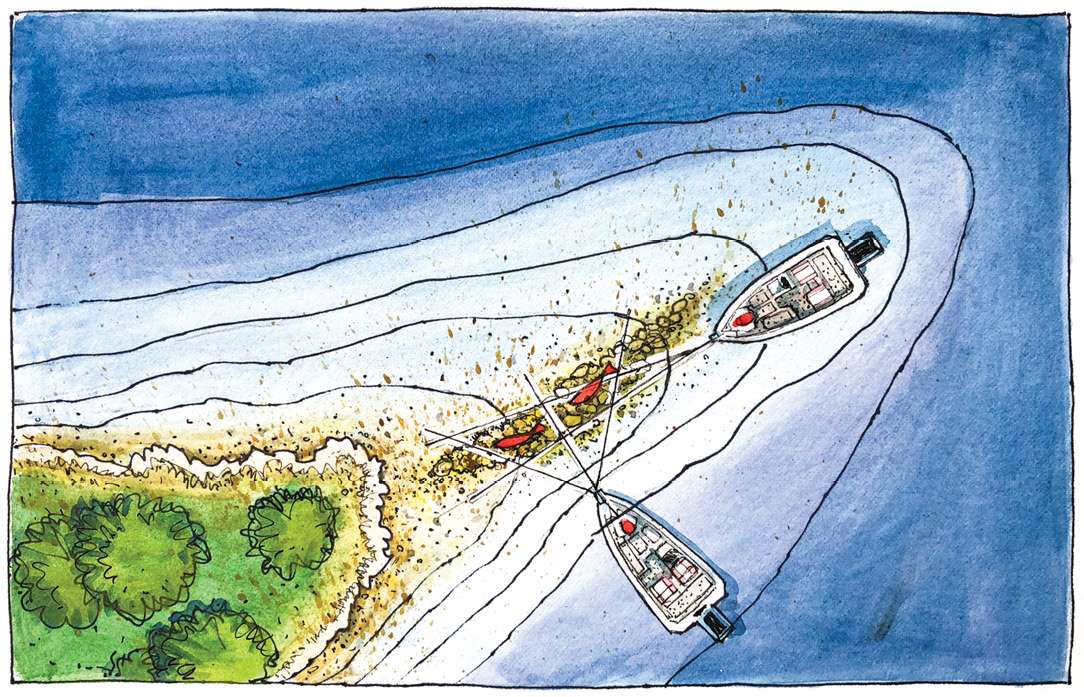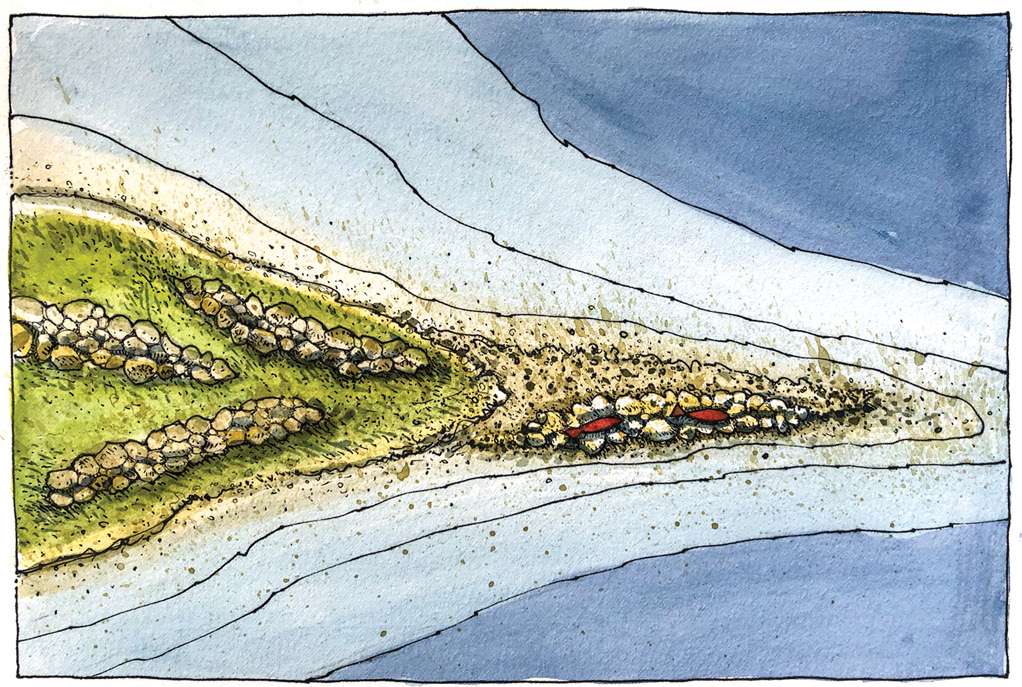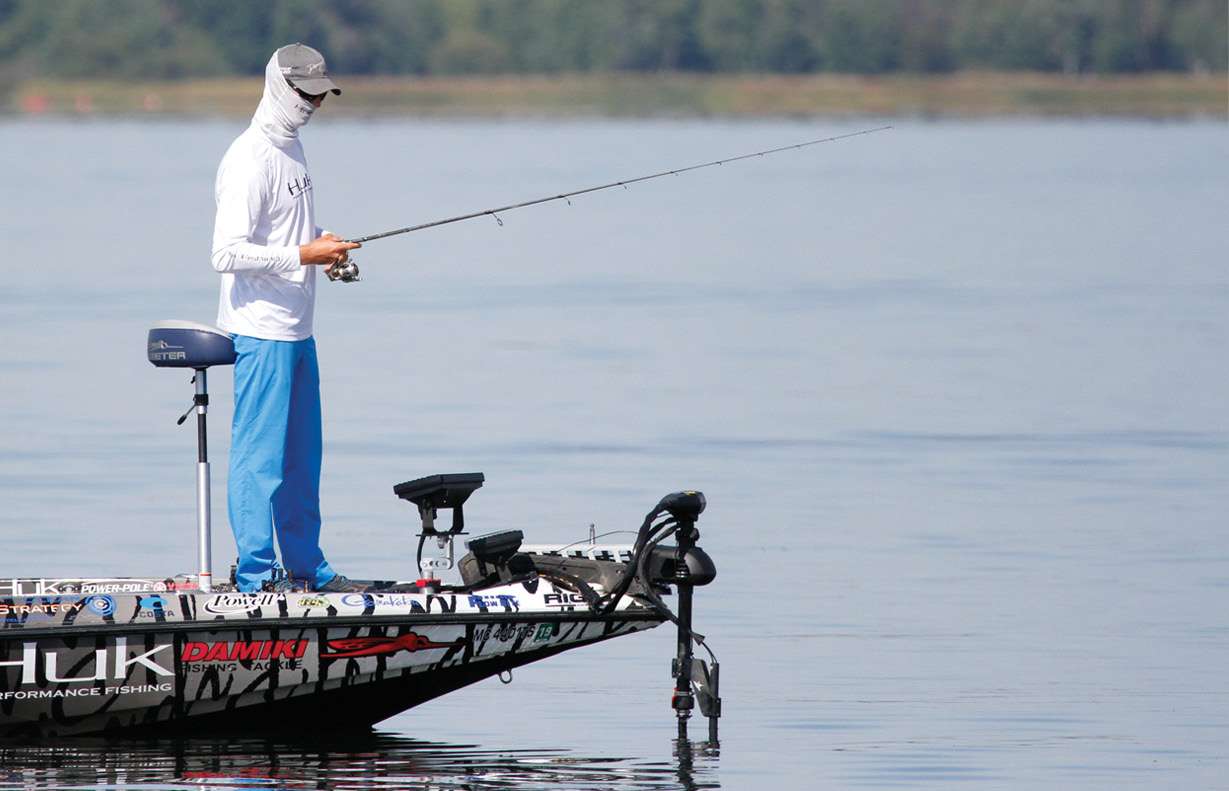
Bassmaster Elite Series pro Chad Pipkens of Michigan was under enormous pressure when he competed in the final Bassmaster Northern Open of 2017 on Douglas Lake, Tennessee. The regular season Elite Series tournaments were over and Pipkens was unsure if he would finish high enough in the Toyota Bassmaster Angler of the Year standings to rejoin the tour in 2018.
However, after the first two Northern Opens of 2017, Pipkens was tied for third place in that division’s AOY standings. If he could catch enough bass at Douglas to stay among the Top 5 in the AOY points, he would earn an invitation to the Elites.
The September tournament proved so stingy that well over half the field failed to catch 10 pounds of bass in two days of fishing. Pipkens eked out 14 pounds, 10 ounces, including a 5-11 largemouth that was the biggest bass of the event. It was enough to land him in fourth place in the final Northern Open AOY points and secure his return to the Elites.
The pattern that saved Pipkens at Douglas was working a drop-shot rig at different angles over rock seams. Many gravel points at Douglas have rock seams that are visible in the shallows and above the surface when the lake is low. Pipkens fished seams 5 to 20 feet beneath the surface that he could see with his Humminbird 360 Imaging sonar.
Seam characteristics
Elite Series pro Brandon Card is well aware of the rock seams at Douglas. The lake is near his Knoxville, Tenn., home and he has fished it many times. Card is even more tuned in to the rock seams at Cherokee, which he regards as his home lake, and at nearby Norris Lake. Grand Lake, Oklahoma, is another lake where Card has plucked bass from seams.
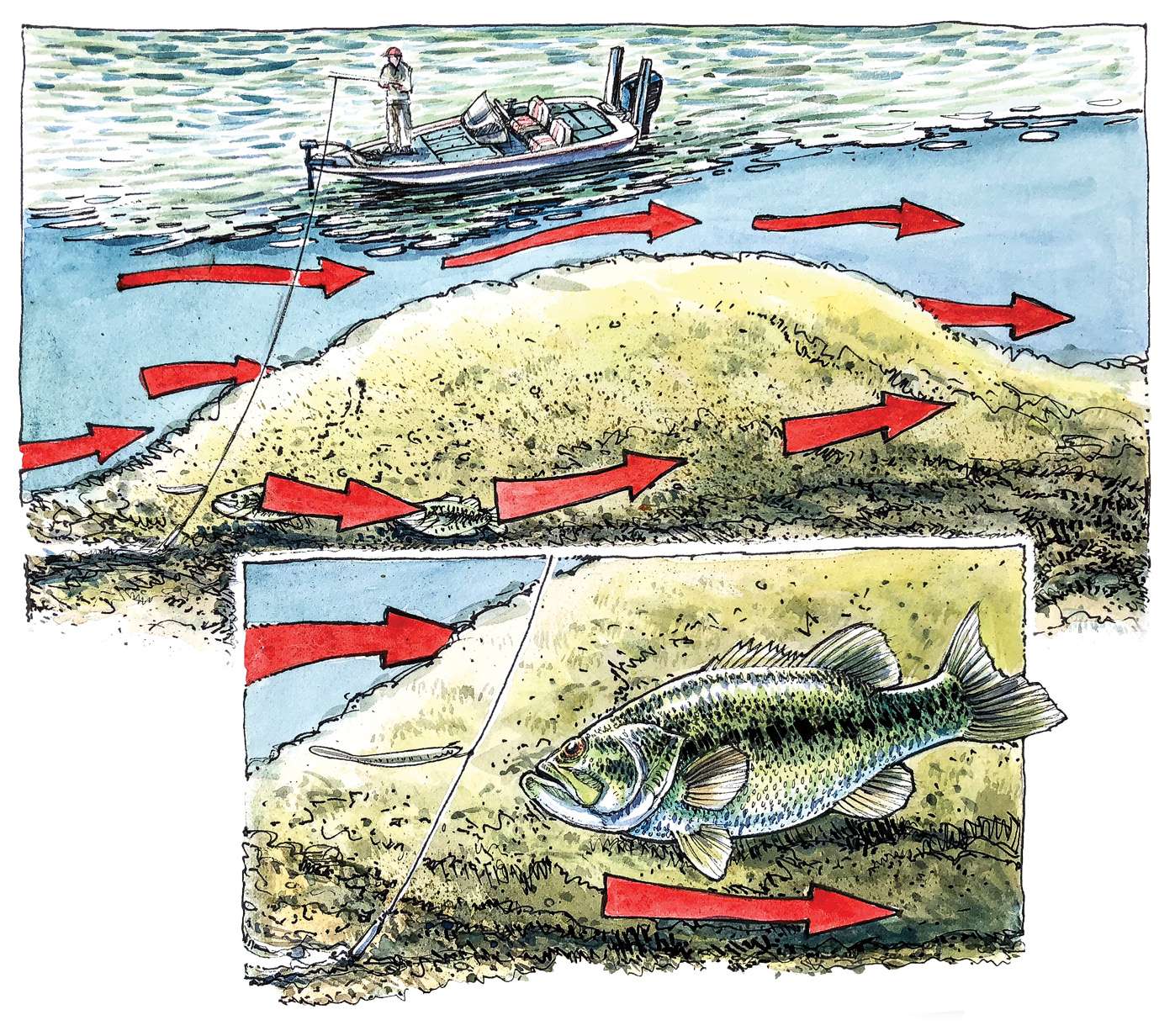
The rock seams at Douglas and many other highland reservoirs are typically found on gravel and clay points, Card explained. Rock seams are especially prominent on lakes that are drawn down during the winter. The fluctuation allows wave action to erode the bottom around the seams and expose the rock.
“The best seams are narrow and have a bare bottom on either side,” Card said. “They stick out like a dinosaur’s backbone.”
Rock seams are not as obvious on all reservoirs that have them. As an example, Card mentioned Grand Lake, where the rock seams are subtle and not as plentiful as those in east Tennessee lakes.
“I rely on my Lowrance SideScan to find rock seams,” Card said. “I set it at 100 feet wide on each side and idle over long, tapering points that reach way off the bank.”
Pronounced seams, such as those at Douglas and Cherokee lakes, show up well at the 100-foot setting, Card said. However, with a subtle seam, you may see only a shadow. To determine if a shadow is a true rock seam, Card sets his SideScan to 40 feet on each side and idles back over the shadow.
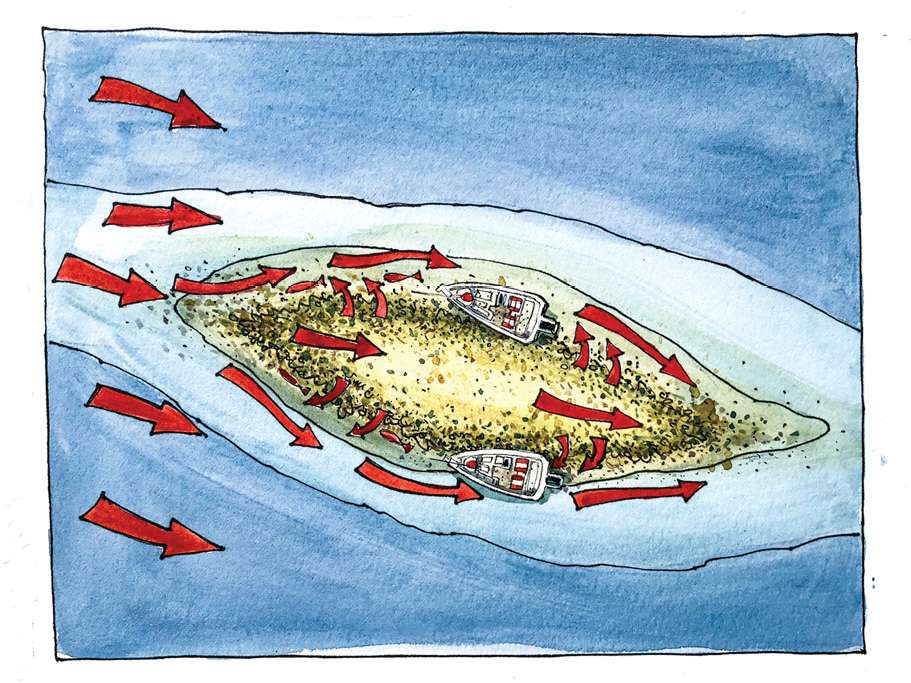
When Card finds a seam, he drops a waypoint on each end of it. With a long seam, he also drops a waypoint or two along its midsection. The waypoints tell him how the seam lies when he returns. Just how Card fishes a seam depends on the season, the water clarity and the species of bass he’s after.
Cash in on rock seams
When Card fishes Cherokee Lake in March, he targets rock seams for smallmouth bass. If heavy spring rains have muddied the water, Card may find the smallmouth on seams as shallow as 2 to 3 feet. With minimal rainfall and clear water, the bass could be on seams 30 feet deep. When he fishes seams less than 10 feet deep, Card triggers strikes with Duel’s Hardcore Shad Crankbait. This lure has the tight wiggling action bass prefer in cold water and it comes in three sizes that dig 3, 6 and 9 feet deep.
“With a crankbait, I can hit a seam at any angle,” Card said. “Casting perpendicular over a seam is always good. The crankbait digs the pea gravel and deflects when it contacts the seam. That is always a key to getting bites.”
A compact, homemade football-head jig is another big hitter for Card when he fishes rock seams at any depth. He trims the jig’s green pumpkin, brown and orange skirt short and dresses the hook with a 4- or 5-inch green pumpkin Yamamoto Double Tail Grub.
“I don’t fish the jig perpendicular to a seam,” Card said. “It gets hung up too much in the rocks that way. I get fewer snags by working the jig straight down the seam.”
By hopping and dragging the jig down the seam, Card also keeps the bait in the strike zone throughout the retrieve. He pointed out that his jig and crankbait combo also snookers largemouth and spotted bass that relate to rock seams.
When smallmouth or spotted bass are on deep seams in clear water, Card picks them off with a 1/4-ounce ball-head jig dressed with a baby bass color 4-inch Yamamoto Single Tail Grub.
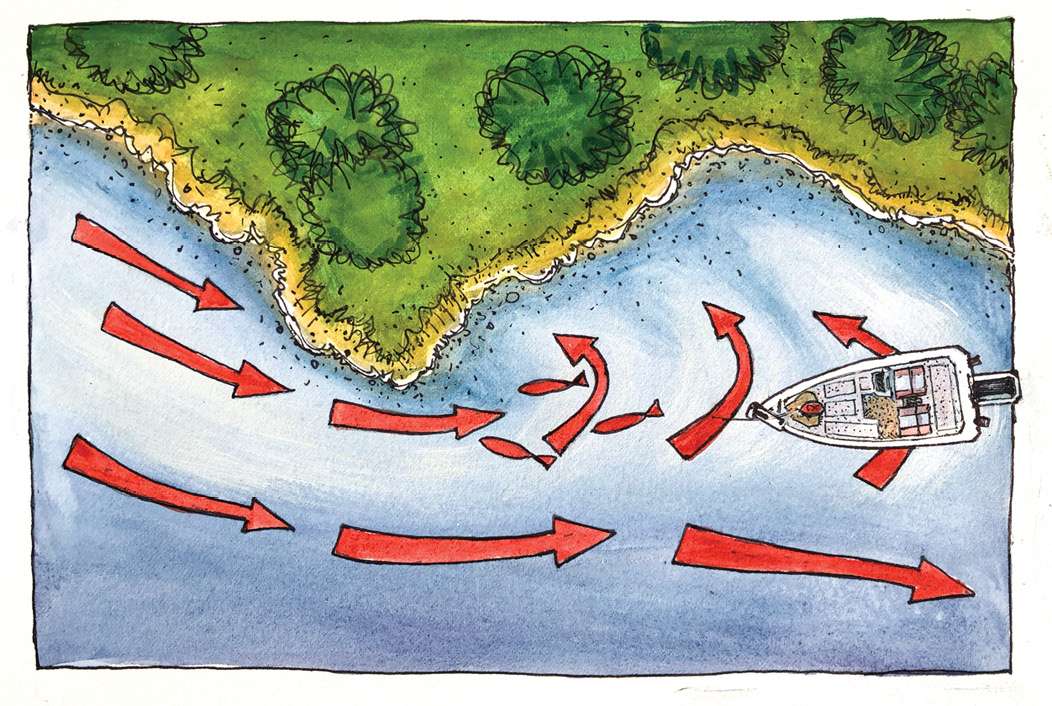
“The jig has to have a short hook,” Card said. “If the hook is too long, it kills the grub’s action. I slow roll the jig down the seam, kind of like I’m fishing a spinnerbait. Every 10 cranks or so, I stop winding and let the bait swim back down to the bottom.”
After the spawn
Card finds few bass on rock seams when the spawn is in full swing, but the bass return to the seams after the spawn. If the water is clear and the bass are no more than 15 feet deep or so, Card goes after them first thing in the morning with his favorite walking topwater stickbait, Yo-Zuri’s 3DR Pencil. On cloudy days, the topwater action may continue all day.
In many areas of the country, smallmouth, largemouth and spotted bass that relate to rock seams can be duped with topwater baits in May and early June. During the summer, jigs and drop-shot rigs work well on deeper seams. The topwater bite picks up again in autumn.
Current seams
Pipkens shines when he fishes current seams for smallmouth bass in the Detroit and St. Lawrence rivers. One place where current seams exist is where a hump in the bottom forces the current to move faster around the high spot than it does over it. Such current seams on the Detroit and St. Lawrence rivers can be hard to see on the surface because they are typically over water deeper than 15 feet.
“I’ve caught smallmouth as deep as 67 feet while fishing current seams on the St. Lawrence,” Pipkens said. “When it’s calm, you can see the smooth water flowing over the high spot and ripples where the current is moving quicker next to it.”
The bass hold in the slower current, often in an eddy, just off the edge of the faster flow. The most effective presentation, by far, is to bring the bait right along the seam where the opposing currents meet. The bait should look natural, like something that’s being pushed downstream with the flow.
Pipkens keeps it real by drifting backward with the current while using his electric motor to keep his bow pointed upstream, to slow his drift and to stay positioned right on the seam. As he drifts backward, Pipkens drags a drop-shot rig or a tube over the bottom. The weight of the drop shot or tube jig should be heavy enough to prevent a big bow in the line, but light enough to let the bait skate over the bottom.
On the St. Lawrence River, Pipkens has drifted down current seams as long as half a mile. The current seams on the Detroit River tend to be much shorter. Some are so small that the drift may last only 30 seconds. In this situation, Pipkens circles back upstream on the slow current side of the seam with his electric motor and repeatedly makes the short drift down the seam.
Shallower current seams
Card also stresses the importance of retrieving your lures with the flow when fishing current seams in shallower water for largemouth, smallmouth and spotted bass. This often happens in river systems and in upriver sections of large reservoirs and in the tailraces of dams.
Rather than drift backward, Card holds his boat facing upstream in the seam on the very edge of the faster flow. In most instances, the current is too strong on the swift-water side of the seam to hold the boat effectively with the electric motor. Once his boat is in position, Card casts directly upstream and retrieves his bait with the current.
“It’s crucial to bring your bait downstream right in the seam,” Card said. “A lot of people cast into the eddy, but the seam is where the active fish are.”
In dingy rivers, Card relies heavily on crankbaits when fishing in water no deeper than 10 feet or so. If the bass are actively feeding, they will come up off the bottom for a tandem willow spinnerbait, which he retrieves just fast enough to keep the blades turning. In deeper water, Card goes with a 3/8- to 3/4-ounce football jig dressed with a Yamamoto PsychoDad. The strength of the current dictates the weight of the jig.
“You want the jig to make bottom contact, but you don’t want it to stay glued to the bottom,” Card said. “When you lift the jig off the bottom, it needs to flow a little bit with the current, like a real crawfish being swept over the bottom.”
Originally published Bassmaster Magazine May 2018
